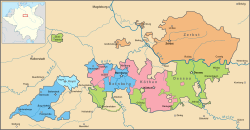Principality of Anhalt-Zerbst Fürstentum Anhalt-Zerbst (German) | |||||||||||||
|---|---|---|---|---|---|---|---|---|---|---|---|---|---|
| 1252–1396 1544–1796 | |||||||||||||
 Anhalt principalities (1747-1793), Zerbst in orange | |||||||||||||
| Status | State of the Holy Roman Empire | ||||||||||||
| Capital | Zerbst | ||||||||||||
| Common languages | Upper Saxon | ||||||||||||
| Government | Principality | ||||||||||||
| Historical era | Middle Ages | ||||||||||||
• Partitioned from Anhalt | 1252 | ||||||||||||
1396 | |||||||||||||
• Partitioned from Anhalt-Dessau | 1544 | ||||||||||||
• Partitioned1 | 1603 | ||||||||||||
• Partitioned2 | 1667 | ||||||||||||
| 1796 | |||||||||||||
• Duchy of Anhalt reunited | 1863 | ||||||||||||
| |||||||||||||
1: In 1603, Anhalt-Zerbst lost territory to Anhalt-Dessau, Anhalt-Bernburg, Anhalt-Plötzkau and Anhalt-Köthen. 2: In 1667, Anhalt-Zerbst lost territory to create Anhalt-Mühlingen and Anhalt-Dornburg. | |||||||||||||
Anhalt-Zerbst was a principality of the Holy Roman Empire ruled by the House of Ascania, with its residence at Zerbst in present-day Saxony-Anhalt. It emerged as a subdivision of the Principality of Anhalt from 1252 until 1396, when it was divided into the principalities of Anhalt-Dessau and Anhalt-Köthen. Recreated in 1544, Anhalt-Zerbst finally was partitioned between Anhalt-Dessau, Anhalt-Köthen, and Anhalt-Bernburg in 1796 upon the extinction of the line.
